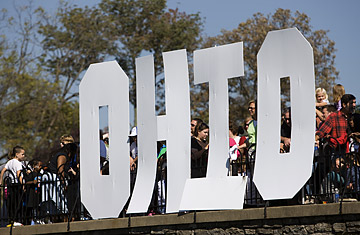
Obama supporters gather at a rally in Cincinnati, Ohio.
People know Ohio as the ultimate swing state, a place where Republicans and Democrats are evenly matched and an entire presidential election can hang by a few thousand votes. But look beneath the surface and you'll see this binary, blue-and-red world dissolve into an uncommonly complicated state that insiders divide into "The Five Ohios." Each of these five regions has its own distinct culture, its own brand of politics. Barack Obama and John McCain know this, and both candidates use different messages and tactics in each area to press their advantages and defend weak flanks.
Obama is leading in Ohio by just three percentage points, within the margin of error, according to the University of Cincinnati's latest Ohio Poll. But only two issues predominate everywhere in Ohio: the economy, and the looming possibility of warfare over election mechanics.
Across Ohio, people are nervous about the economy. The state has lost almost a quarter million jobs since 2000, its worst drop since the Great Depression. In some of the state's most politically divided areas, including Sandusky and Lima in northwest Ohio, a third of all manufacturing jobs disappeared in the last seven years. These economic concerns have helped Obama, who took the lead in polls only after the Wall Street bailout.
Ohioans are also concerned about whether their votes will count. One major issue is what to do about the provisional ballots that voters receive when their personal information does not appear correctly on election rolls. (If the information later checks out, their votes count; if not, the votes are discounted.) Until recently, each of Ohio's 88 counties counted provisional ballots differently. The Northeast Ohio Coalition for the Homeless won a lawsuit forcing Secretary of State Jennifer Brunner to impose consistent rules statewide. But because the ruling came just two weeks ago, insiders worry that the disorder may not be cleared up in time. "It's still a mess," says Caroline Gentry, a lawyer for the coalition. "If it's a close election, I do think there will be litigation."
Ohio's largest population centers are not really in play this election season, according to Eric Rademacher, co-director of the Ohio Poll. McCain likely will perform well in southwest Ohio, which includes Cincinnati, Dayton and their exurbs, despite Obama's success registering new voters and his strength among Cincinnati's African-American population. "McCain expects his core voters to come out" in Cincinnati, Rademacher says. "Obama is just trying to minimize the damage."
In the state's opposite corner, Obama is projected to win big in Cleveland, Akron and Canton, which were suffering long before Wall Street imploded. McCain's two-day bus tour through the region this week was aimed at trying to pick off a few outlying, affluent suburbs where his tax plan is popular. Yet Obama still looks strong there. "If Obama can run up big numbers in the suburbs outside Cleveland, then this thing could be a blowout," says Mike Curtin, publisher emeritus of The Columbus Dispatch.
That leaves the "battleground state" with only three true battlegrounds:
• The Farm Belt, Northwest Ohio
Many of Ohio's far-right leaders grew up here. But some the area's cities lost a third of their manufacturing jobs in the last seven years, giving Democrats an opening. Still, it is seen as Republican territory. Sarah Palin chose Northwest Ohio's Bowling Green University last week to roll out new accusations of Obama's links to radicals. Expect more such red meat appeals to the base. Meanwhile, in an effort to expand past his Toledo stronghold, Obama sent Joe Biden and Bill Clinton to rallies in factory towns like Lima and Marion in recent days. Result, says Rademacher: "Northwest Ohio is just too close to call."
• The Coal Belt, Southeastern Ohio
Appalachia has the highest unemployment and lowest education levels in the state. And it likes to play the maverick. Sixteen counties here supported Bill Clinton in 1996, only to flip four years later and give George Bush the votes to carry Ohio.
Obama got creamed here in the primaries. But now he has two popular surrogates: Ted Strickland, who spent 12 years representing this area in Congress before becoming governor, and Hillary Clinton, who barnstormed here on Friday. McCain appeared here in two rallies last week, where he focused on middle class economic issues. "That region has many people who like their guns, are fairly religious, and some have questions about voting for a black candidate," says Dave Cohen, a political science professor at the University of Akron. "But Obama has Strickland, which is a huge advantage."
• The Suburb Belt Around Columbus
For decades, Ohio's sprawling capital city preferred milquetoast Republicans like George Bush Sr. As conservatives move into the exurbs, though, the city swung toward milquetoast Democrats like John Kerry. Its diversified, white-collar economy is doing better than the rest of the state, which means other issues including health care and the Iraq war are also on voters' minds.
In this middle-of-the-road area, both campaigns are fighting for the center; that will make the ground game even more important. "The suburbs of Columbus have very high turnout already," says David Wasserman, an analyst for the Cook Political Report. "The real question is which campaign can stimulate turnout in the urban areas. I see this race as a real tossup right now."
(See photos of both Barack Obama and John McCain's final days on the campaign trail)
